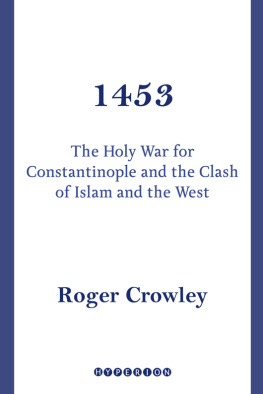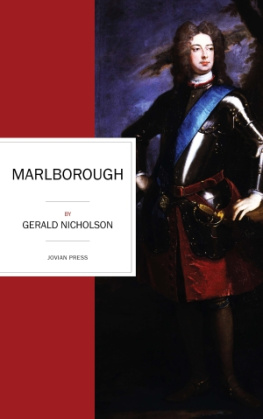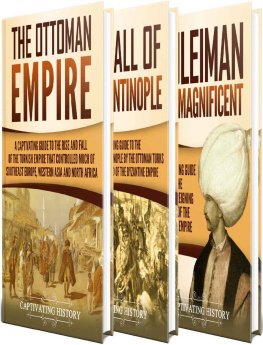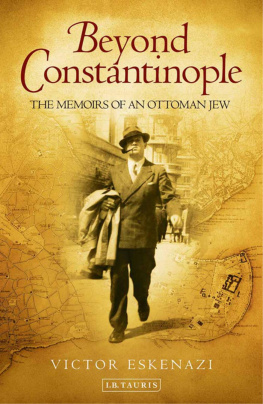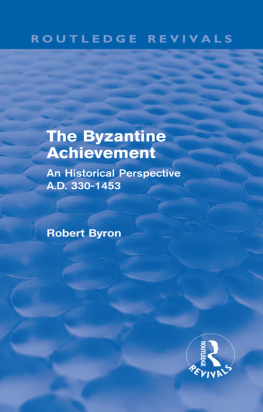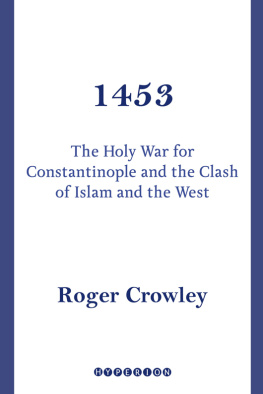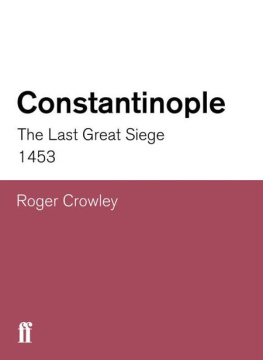
There were so many events in this war that the pen cant describe them all, the tongue cant list them all.
Neshri, fifteenth-century Ottoman chronicler
The Fall of Constantinople or the Capture of Istanbul was a fulcrum moment in the Middle Ages. The news spread across the Muslim and Christian worlds with astonishing speed, and a hungry interest in the story has ensured the survival of a huge number of accounts, so that the event seems to be blessed with a unique assemblage of reports. On closer examination, however, the sum of the parts is slightly less than the whole. The band of eyewitnesses is actually quite small, and largely Christian; many of their names will have become familiar to the readers of this book: Archbishop Leonard of Chios, the intemperate Catholic churchman; Nicolo Barbaro, the ships doctor who wrote the most reliably dated diary; Giacomo Tetaldi, a Florentine merchant; the Russian Orthodox Nestor-Iskander; Tursun Bey, an Ottoman civil servant; and one or two others, such as George Sphrantzes, whose chronicles have proved something of a headache for modern historians. Behind these participants come a tight group of immediate successors who lived close to the moment and who probably heard the story soon afterward secondhand Doukas, the irrepressible Greek chronicler, vivid, unreliable, and full of apocryphal stories, who imparts a lively energy to the story and another Greek, Kritovoulos, a judge on the island of Imbros, unique in writing a Christian but pro-Ottoman version. (One of his many ambitions for his work was for it to be read by all the western nations, including those who inhabit the British Isles.) Successive centuries see a wealth of further versions from both sides; some of these are straight retellings, others add hearsay, lost oral accounts, myth, and Christian or Ottoman imperial propaganda to create a heady mix of unverifiable information. It is out of such a bag of narratives that this book has been fashioned.
Many of the difficulties that arise from handling the sources are of course endemic to history, particularly history before the age of science. Eyewitnesses at the siege are notoriously prone to large round numbers when estimating army sizes and casualty figures, hazy on dates and times, given to the use of infuriatingly local systems of weights and measures, and keen to exaggerate for a receptive audience. The chronological sequencing of events is usually a convention waiting to be invented, and the distinction between fact, story, and myth is a fine one. Religious superstitions are so deeply intertwined with events that the citys fall is a narrative about what people believed as well as what actually happened. And of course the notion of an objective account is entirely alien throughout.
Every writer has an angle and a motive for his version, and it is necessary to pick carefully through the claims and special interests of each one. Judgments are routinely made on the basis of religion, nationality, and creed. Venetians will automatically talk up the valor of their sailors and denigrate the treachery of the Genoese and vice versa. Italians will accuse the Greeks of cowardice, laziness, and stupidity. Catholics and Orthodox will hurl insults at each other over the parapets of schism. Within the Christian camp the search for an explanation, either theological or human, for the loss of the city is a prime motivation, and the blame culture rings loudly through the pages. And of course all the Christian writers hurl routine abuse at the blood-drinker Mehmet with the exception of Kritovoulos, who leans over backward to ingratiate himself with the sultan. The Ottomans naturally return these insults in kind.
The tale that these witnesses tell is always vivid they were conscious that they had witnessed, and survived, the most extraordinary event but the versions are full of strange silences. Given the huge significance of 1453 to the history of the Turkish people, it is surprising that there are so few contemporary Ottoman accounts of the capture of the city, no eyewitness narratives, almost no personal reports of the feelings and motivations of the Muslim soldiers, apart from Sheik Akshemsettins letter to Mehmet. The society was predominately preliterate; transmission of events was largely oral, with no tradition of recording individual stories. What does exist is in the form of terse chronicles, later reworked to serve in the creation of an Ottoman dynastic legend, so that the Ottoman perspective often has to be constructed by reading between the lines of Christian accounts: 1453 is unusual in being history largely written by the losers.
Almost as surprising is the shortage of testimony from Orthodox Greeks. Perhaps because many of the leading Byzantines were killed in the final sack, or were possibly too traumatized, like George Sphrantzes, to dwell on the details, the Christian story is largely relayed by Italians or prounionist Greeks who give the Orthodox defenders of the city, with the exception of Constantine, an unstintingly bad press.
As a consequence the story contains a large number of mysteries that will probably never be resolved. How the Ottomans transported their ships remains a lively subject for debate among Turkish historians, while the death of Constantine is maddeningly elusive the competing versions divide neatly along party lines; indeed Constantine himself remains a shadowy figure beside the impatient, irrepressible person of Mehmet, who seems to be omnipresent in the siege.
My aim in retelling the tale of Constantinople has been to construct out of these conflicts and difficulties a robust central version of events as close to certainty as I can make it. I have picked my way through the sources, awkwardly at times, trying to square accounts and seeking the most likely explanations. Dates are notoriously uncertain, despite Barbaros diary, which does narrate the siege day by day. Every account chooses a different line in the detail of the sequencing and dating of events, and many who have studied the subject will disagree with me on fine points. A forensic study of this book will reveal some small mysteries in the timing of events. I have let these stand as a record of what is unknowable and cannot be reconciled. I have decided in general to choose the chronology that seems to me most likely and to limit, as far as possible, the dreaded words perhaps, possibly, and might have from my narrative. The alternative was to bog the general reader down in variant source versions, which would have added little to the overall dynamic of a story whose outlines are strong and brilliantly colored. At the same time I have drawn straight lines to deductions that I feel are justifiable from the physical evidence of geography, landscape, weather, and time.
My second aim for this book has been to capture the sound of human voices to reproduce the words, prejudices, hopes, and fears of the protagonists firsthand and to tell something of the story of the story, the versions that they believed to be true as well as the verifiable facts. The sources are often personalities in their own right, almost as exotic and mysterious as the tale they tell; some, such as Barbaro, exist only in their telling and vanish back into silence. Others, such as Leonard of Chios and Isidore of Kiev, are more deeply embedded in the church history of the period. Among the most fascinating and problematic of the accounts is that of the Orthodox Russian Nestor-Iskander, who seems to have come to Constantinople as a conscript in the Ottoman army. By deduction it appears that he escaped into the city early in the siege, witnessed and participated in its events he is particularly vivid on the subject of bombardment and events on the wall and survived Ottoman retribution afterward, possibly disguised as a monk in a monastery. His mystical and often fantastic mixture of legend, hearsay, and firsthand observation is so confused about dates and sequence that many writers have been inclined to dismiss it altogether, but it contains a mass of convincing details he is uniquely concrete about the struggle for the wall and the process of disposing of the dead, a task in which he was probably involved. Almost alone among the sources, Nestor-Iskander also gives us reports of the Greeks actually fighting, for example in the incident that leads to the death of Rhangabes. The Venetians and Genoese would have us believe it was an almost exclusively Italian affair, with the Greek population at best passive and at worst, because of religious differences, obstructive, profiteering, and cowardly.
Next page
